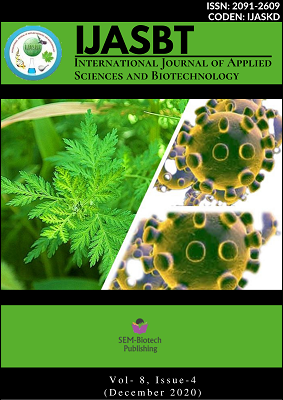In-Vitro Evaluation of Biofilm and Hemolysis activity of Candida albicans Isolated from Oral Cavity
DOI:
https://doi.org/10.3126/ijasbt.v8i4.32971Keywords:
Candida albicans, Biofilm, Hemolysis, Tissue culture plate method, NepalAbstract
Candida albicans is a member of the healthy human microflora, colonizing several niches in the body and can cause opportunistic infection under host debilitated and immunocompromised condition. The present study aimed to investigate the in-vitro hemolytic activity of C. albicans isolated from oral cavity and screen biofilm through three different methods. During the study, 200 oral rinse samples from general human population were analyzed in microbiology laboratory of Central Campus of Technology, Tribhuvan University, Hattisar, Dharan. Nepal. Candida albicans were isolated and identified by conventional microbiological procedures. The hemolytic activity was evaluated through two different Sabouraud dextrose broth media (SDB) containing 7% defibrinated human blood, one supplemented with 3% glucose (SDBwG) and the other without glucose (SDBwoG). The biofilm formation was screened through congo red agar, tube method and tissue culture plate method. In this present study, 42 (21%) isolates of Candida albicans were isolated from 200 oral rinse samples. Isolated Candida albicans exhibited mean hemolysis activity of 28.66% on human blood SDB without glucose and 43.55% on human blood SDB with 3% glucose. Tissue culture plate method was considered sensitive, specific and accurate method for quantitative screening of biofilm in comparison to tube method and congo red agar method. This research concluded that Candida albicans exhibited greater hemolytic activity in human blood with glucose (SDBwG) than in human blood without glucose (SDBwoG). This finding explains that an increased blood glucose concentration may contribute to increased hemolysis activity of Candida albicans that could play pathogenic role for inducing infection like oral candidiasis in debilitated host like diabetic patients. Tissue culture plate method can accurately screen biofilms than tube and congo red agar method.
Int. J. Appl. Sci. Biotechnol. Vol 8(4): 394-399




